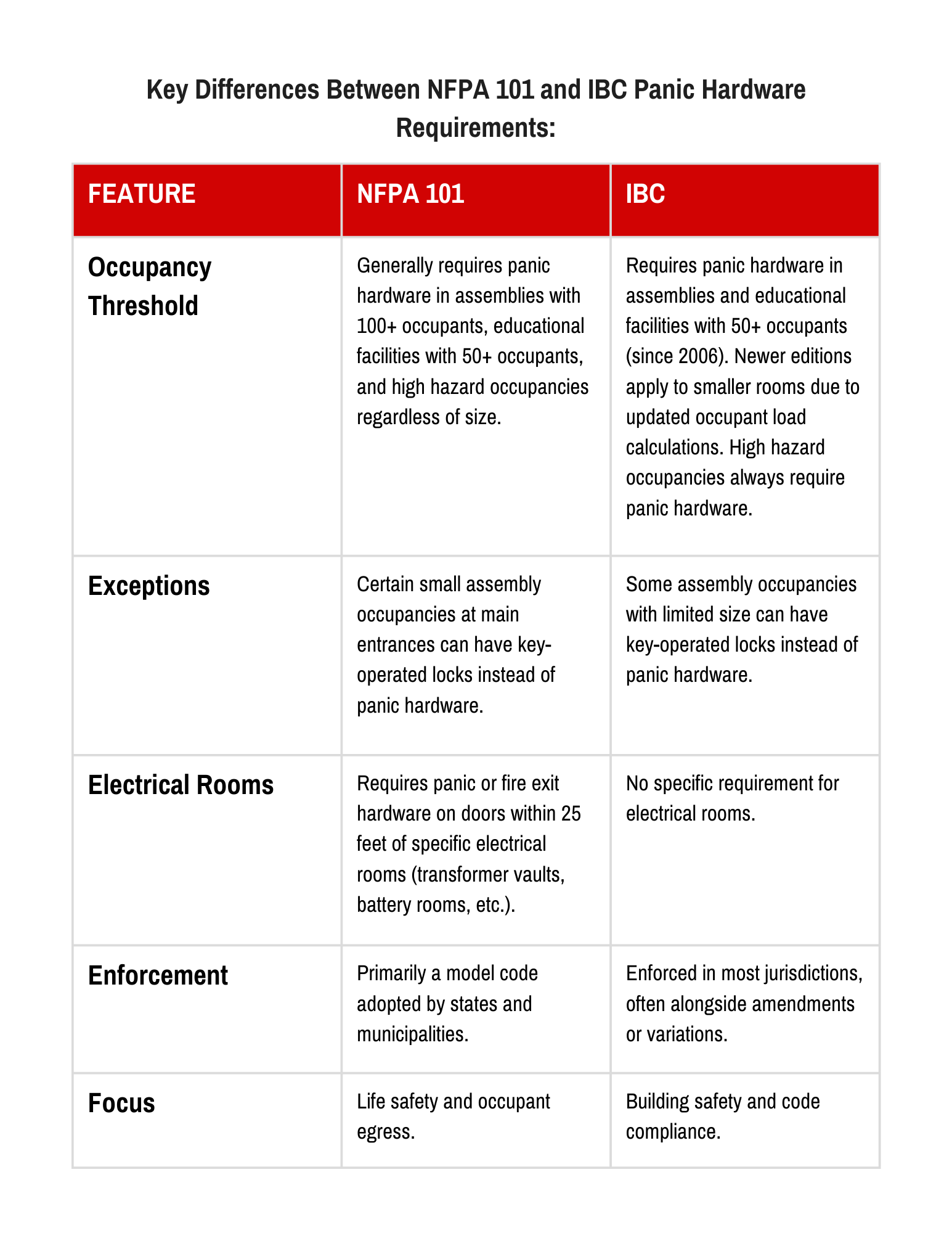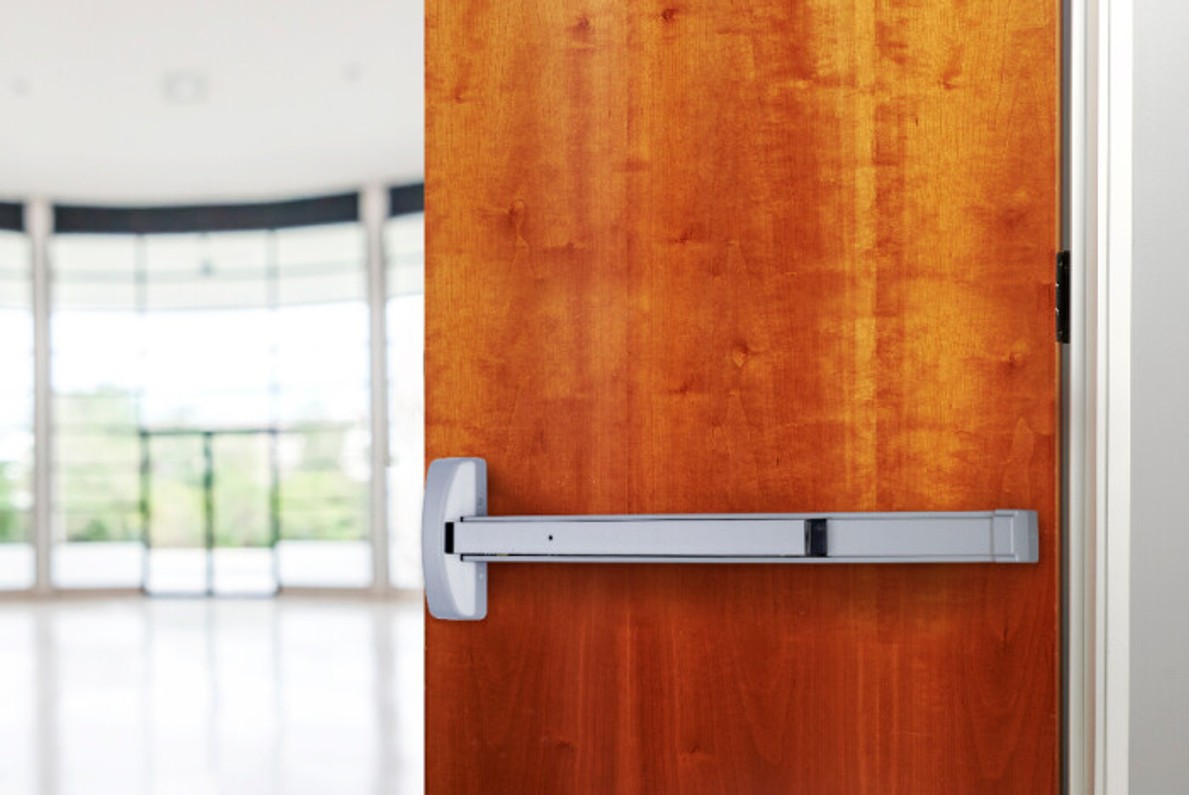Demystifying Panic Hardware Codes: A Roadmap for Facility Managers
Many facility managers grapple with the question: "When is panic hardware required?" It's true that panic hardware, also known as exit devices, offers quick and easy egress in emergencies, making it popular even beyond code mandates. However, navigating the intricate web of regulations governing its use can be tricky. This guide provides a roadmap, helping you understand when and where panic hardware becomes essential.
Beyond Convenience: Safety Takes Priority
While the user-friendliness of panic hardware makes it tempting for widespread use, understanding code requirements is paramount for occupant safety. This guide delves into the specific situations where building codes demand panic hardware installation, ensuring your projects adhere to legal and life-saving regulations.
Exploring the Code Maze
Get ready to explore the code jungle! We'll navigate through key publications like the Life Safety Code (NFPA 101) and the International Building Code (IBC), uncovering their panic hardware requirements. Along the way, we'll highlight potential variations depending on the specific code edition and jurisdiction.
When the Code Gets Specific
This guide goes beyond the basic code requirements. We'll delve into specific circumstances that trigger the need for panic hardware, such as:
- Occupancy type and size: Different occupancies, like assembly halls or educational facilities, might have specific size thresholds requiring panic hardware.
- Electrical additions: While panic hardware offers valuable functionality, adding features like electric latch retraction or delayed egress introduces additional code considerations.
Unlocking the Right Hardware: Selection Criteria
With the "when" of panic hardware covered, we'll move on to the "how." This guide explores different types of panic hardware based on factors like aesthetics, door design, and functionality. Additionally, we'll discuss various options like trims, finishes, and dogging mechanisms to help you choose the right hardware for your project.
Demystifying Electrified Functions
The confusion surrounding panic hardware often stems from electrified functions. This guide clarifies the codes relating to electric latch retraction, delayed egress, and controlled egress, empowering you to make informed decisions when incorporating these features.
Remember: Local Variations Exist
While this guide provides a comprehensive overview, remember that local jurisdictions may have their own amendments or variations to national codes. We recommend consulting local authorities for definitive requirements in your specific area.
By following this roadmap, you'll gain a deeper understanding of panic hardware codes, ensuring your projects meet safety standards and deliver the peace of mind that comes with knowing you've prioritized the wellbeing of occupants.
Ready to explore further? Stay tuned for the next sections, where we'll delve deeper into each aspect of navigating panic hardware requirements!
Panic Hardware Codes: Where Do They Apply?
Understanding panic hardware regulations can be overwhelming, especially with variations across codes and editions. This section dissects the key requirements and exceptions you need to know.

Additional Notes:
- Both codes require fire exit hardware on fire doors, which is a type of panic hardware with additional fire resistance testing.
- Both codes have additional requirements beyond the points listed here, such as specific door types, activation force, and signage.
- Always consult the specific code editions and local amendments for definitive requirements in your area.
The Big Picture:
- NFPA 101 (Life Safety Code) and IBC (International Building Code) set the main guidelines for panic hardware use.
- Crucially, requirements differ depending on the specific code edition and local jurisdiction.
- Electrified features like electric latch retraction or delayed egress add further complexity.
Breaking Down the Rules:
- IBC (since 2006): Mandates panic hardware in Assembly and Educational occupancies with 50+ occupants (and all High Hazard occupancies). Note that newer editions require it for smaller rooms due to changes in occupant load calculations.
- Exceptions: Certain Assembly occupancies with limited size can have key-operated locks instead of panic hardware at the main entrance.
- NFPA 70 (2017): Requires panic or fire exit hardware on doors within 25 feet of specific electrical rooms (transformer vaults, battery rooms, etc.).
Additional Requirements and Exceptions:
- NFPA 70: Previous editions may have slightly different rules for electrical rooms. Mechanical rooms like boilers or refrigeration areas might also require panic hardware in some cases. Remember, NFPA 70 generally takes precedence when adopted locally.
- Authority Having Jurisdiction (AHJ): They can request panic hardware even beyond code mandates for enhanced life safety.
- Push/Pull Doors: If a door lacks a latch or lock (push/pull style), panic hardware isn't necessary.
- Multiple Doors: Typically, if one door in a specific area requires panic hardware, all doors along the egress path (exit access, exit, and discharge) do as well. This excludes doors mandated by the National Electrical Code's 25-foot proximity rule.
Panic Hardware vs. Fire Exit Hardware:
- Panic Hardware: Listed under UL 305, used on non-fire-rated doors.
- Fire Exit Hardware: A type of panic hardware additionally tested for fire doors (UL 10C listing).
- Dogging Feature: Not present in fire exit hardware. Fire doors need active latches during a fire. Electric latch retraction for temporary dogging might be used, but the latch must automatically engage upon the fire alarm.
Other Crucial Considerations:
- Actuating Device Size: Must be at least half the door width.
- Mounting Height: Current codes specify 34-48 inches above the floor.
- Operation Force: Varies between 5 and 15 pounds depending on codes. Certain panic hardware is UL-listed for the lower 5-pound force.
- Additional Locking Devices: Generally prohibited, with exceptions like sensor-released electromagnetic locks, 15-second delayed egress locks, and controlled egress devices in specific healthcare settings.
- Fire Doors and Labeling: When panic hardware is used on fire doors, it must be fire exit hardware with appropriate UL listings and labeling.
- Balanced Doors: Pushpad/touchpad devices are required, not exceeding half the door width. Crossbar styles are not allowed due to potential misuse.
- Regional Requirements: Doors and hardware might need to meet hurricane or tornado protection standards in certain areas. Check relevant codes and manufacturer certifications.
Choosing the Right Panic Hardware: Style & Function
Now that we've covered the "when" of panic hardware, let's explore the "how." Here's a breakdown of different styles and types to help you make the best choice:
Styles:
- Touchpad: Popular for modern buildings, offering flexibility for electric options like delayed egress. Consider door style and size for appropriate width.
- Crossbar: Ideal for minimal aesthetics or a vintage look, but limited in electric options due to space constraints. Ensure your door's vertical stiles accommodate the chosen width.
- Minimizes projection but requires door cut-outs and might be limited to hollow metal doors.
Types (based on door configuration and function):
- Rim: Simple, surface-mounted option for single or double doors with removable mullions (ideal for security and easy removal). Rim panic devices offer a straightforward and reliable solution for emergency exits. Here's what makes them stand out:
- Simple Installation: Unlike mortise devices, they are surface-mounted on the door, meaning no complex cutting or drilling is required. This makes them easier to install and maintain.
- Versatility: They work on single doors or pairs with a removable mullion, providing flexibility for various openings.
- Enhanced Security for Pairs: The rim x rim x removable mullion setup provides superior security for double doors. Unlike vertical rod devices, less precise door alignment is needed, reducing potential vulnerabilities.
- Removable Convenience: The key-removable mullion allows authorized personnel to easily take it off when the full width of the opening is needed, offering added practicality.
- Simple Operation: Pushing the panic bar activates the latch, regardless of direction or force applied. This simplicity ensures smooth and fast egress in emergencies.
Ideal Choice for:
- High-traffic areas
- Retail stores
- Schools
- Offices
- Healthcare facilities
Remember, while rim panic devices offer convenience and security, always ensure they comply with relevant building codes and fire safety regulations in your area.

- Mortise: While not as frequently seen as rim devices, mortise panic devices offer distinct advantages for specific applications:
- Hidden Strength: Unlike rim options with surface-mounted locks, mortise devices embed a lock body deeper within the door. This can translate to enhanced physical security and a sleeker aesthetic.
- Fire-Rated Applications: In pairs of fire doors requiring a 3-hour rating, mortise fire exit hardware is sometimes used on one leaf, often paired with vertical rod hardware on the other. However, advancements have led some manufacturers to successfully achieve the 3-hour rating with vertical rod devices on both leaves.
- Key Considerations:
- Installation Complexity: Compared to rim devices, mortise installations require more intricate door preparation due to the lock body integration.
- Less Common Design: The product options and availability might be limited compared to rim counterparts.
Ideal Choice for:
- High-security areas
- Architecturally sensitive spaces where aesthetics matter
- Specific fire-rated door setups
Before choosing:
- Consult a qualified professional to assess your project's specific needs and code requirements.
- Evaluate the trade-off between security, aesthetics, and installation complexity.

- Vertical Rod/Cable: Typically for pairs of doors, available in surface-mounted, concealed (with cables for easier maintenance), and "less bottom rod" (LBR) fire-rated options.
- Multi-point: Combines vertical rods and a rim device for 3-point latching, used for security or windstorm requirements.
Trims and Controls:
- Exterior Trim: This controls unlocking from the outside. Options include:
- Exit-only: No trim, for emergency egress only.
- Nightlatch: Used for "dogging" the door open, with various combinations of cylinders, pull handles, or lever handles. Some include thumb turns for extra leverage.
- Lever Trim: Offers passage, storeroom, or classroom functions, with or without electric options. Knobs and thumb pieces are less common due to accessibility requirements.
Finishes:
- Choose from a variety of architectural plated finishes, stainless steel (for stainless steel hardware), or powder coat finishes in standard and custom colors.
Dogging:
- This holds the latch open for frequent use, reducing wear and tear.
- Specify your preferred dogging method: hex-key or key cylinder.
Electrified Functions:
- Enhance functionality with features like:
- Electric latch retraction for remote unlocking.
- Electrified lever trim for access control.
- Delayed egress to control exiting speed.
- Controlled egress for specific areas.
- Alarms and switches for additional security and monitoring.
Demystifying Electrified Options:
Panic hardware often raises questions about electrified features like electric latch retraction, delayed egress, and controlled egress. Let's break down each one:
Electric Latch Retraction (EL, QEL, ELR):
- Can it be used on fire doors? Yes, but with conditions. Fire doors require positive latching during a fire. While electric latch retraction allows push/pull functionality, the latch must automatically project upon fire alarm activation.
Delayed Egress:
- What is it? Delays door opening from the exit side for 15-30 seconds, preventing theft or elopement while maintaining life safety.
Code Requirements:
- Varies by occupancy type and code editions. Generally allowed in specific occupancies with limitations.
- Requires signage, audible alarms, immediate egress upon fire/power loss, and manual reset.
Controlled Egress:
- Similar to delayed egress, but with key differences:
- Used in specific healthcare facilities (I-1 and I-2 occupancies) for preventing elopement or abduction.
- Unlocks upon fire/power loss, remote activation, or by staff at any time.
- No requirement for a 15-second delay.
Key Takeaways:
- Electrified features offer additional functionality but come with code requirements and limitations.
- Each function (electric latch retraction, delayed egress, controlled egress) has specific uses and regulations.
- Understanding these distinctions is crucial for safe and compliant implementation.
Making Sense Of It All
While the codes surrounding the use of panic hardware can seem confusing and sometimes even contradictory, the role these products play in ensuring life safety and security within the built environment makes it vital that they be specified and installed correctly every time. Always verify which code and edition are to be used as well as the occupancy classification of the project, then apply the appropriate requirements to ensure that your specification and/or installation is code compliant.
Sources: Allegion, Falcon, Adams Rite, International Building Code 2024, NFPA
Recent Posts
-
One Priority, Multiple Strategies: Finding the Right Lockout Tagout Program for Your Facility with Smallwood Lock & Supply
At Smallwood Lock & Supply, we understand that workplace safety is paramount. Developing an effe …May 13th 2025 -
Beat the Business Heat: Safeguarding Your Commercial Locks and Door Hardware This Summer
As temperatures soar, businesses must know that the scorching summer heat can wreak havoc on your co …Jun 20th 2024 -
Lockout/Tagout Safety: Master Lock, American Lock, and ABUS Padlock Solutions for Your Facility
Lockout/Tagout (LOTO) procedures are non-negotiable in industries where equipment maintenance poses …Apr 9th 2024




